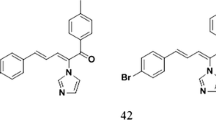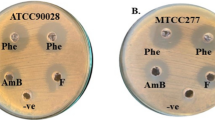Abstract
The increase in drug resistance to current antifungal drugs brings enormous challenges to the management of Candida infection. Therefore, there is a continuous need for the discovery of new antimicrobial agents that are effective against Candida infections especially from natural source especially from medical plants. The present investigation describes the synergistic anticandidal activity of two asarones (∞ and β) purified from Acorus calamus in combination with three clinically used antifungal drugs (fluconazole, clotrimazole, and amphotericin B). The synergistic anticandidal activities of asarones and drugs were assessed using the checkerboard microdilution and time-kill assays. The results of the present study showed that the combined effects of asarones and drugs principally recorded substantial synergistic activity (fractional inhibitory concentration index (FICI) <0.5). Time-kill study by combination of the minimal inhibitory concentration (MIC) of asarones and drugs (1:1) recorded that the growth of the Candida species was significantly arrested between 0 and 2 h and almost completely attenuated between 2 and 6 h of treatment. These findings have potential implications in adjourning the development of resistance as the anticandidal activity is achieved with lower concentrations of asarones and drugs. The combination of asarones and drugs also significantly inhibit the biofilm formation by Candida species, and this would also help to fight against drug resistance because biofilms formed by Candida species are ubiquitous in nature and are characterized by their recalcitrance toward antimicrobial treatment. The in vitro synergistic activity of asarones and drugs against pathogenic Candida species is reported here for the first time.




Similar content being viewed by others
References
Afeltra, J., & Verwrji, P. E. (2003). Antifungal activity of non-antifungal drugs. European Journal of Clinical and Microbiological Infectious Diseases, 22, 397–407.
Wilson, L. S., Reyes, C. M., Stolpman, M., Speckman, J., & Allen, K. (2002). The direct cost and incidence of systemic fungal infections. The direct cost andincidence of systemic fungal infections. Value in Health, 5, 26–34.
Gudlaugsson, O., Gillespie, S., Lee, K., Vande Berg, J., & Allen, K. (2003). The direct cost and incidence of systemic fungal infections. Value in Health, 37, 1172–1177.
Chi, H. W., Yang, Y. S., Shang, S. T., Chen, K. H., Yeh, K. M., Chang, F. Y., & Lin, J. C. (2011). Candida albicans versus non-albicans bloodstream infections: the comparison of risk factors and outcome. Journal of Microbiology and Immunological Infections, 44, 369–375.
Iwazaki, R. S., Eliana, H. E., Ueda-Nakamura, T., Nakamura, C. V., Garcia, L. B., & Filho, B. P. D. (2010). In vitro antifungal activity of the berberine and its synergism with fluconazole. Antonie van Leeuwenhoek, 97, 201–205.
Marchetti, O., Moreillon, P., Entenza, J. M., Vouillamoz, J., Glauser, M. P., & Bille, J. (2003). Fungicidal synergism of FLU and cyclosporine in Candida albicans is not dependent on multidrug efflux transporters encoded by the CDR1, CDR2, CaMDR1, and FLU1 genes. Antimicrobial Agents and Chemotherapy, 47, 1565–1570.
Georgopapadakou, N. H., & Tkacz, J. S. (1995). The fungal cell wall as a drug target. Trends in Microbiology, 3, 98–104.
Cabrala, M. E., Lucía, I. C., Figueroaa, B., Julia, I., & Farĩna, A. (2013). Synergistic antifungal activity of statin–azole associations as witnessed by Saccharomyces cerevisiae- and Candida utilis-bioassays and ergosterol quantification. Revista Iberoamericana de Micología, 30(1), 31–38.
Gilani, A. U., Shah, A. J., Ahmad, M., & Shaheen, F. (2006). Antispasmodic effect of Acorus calamus is mediated through calcium channel blockade. Phytotherapy Research, 20, 1080–1084.
Meena, A. K., Rao, M. M., Singh, A., & Kumar, S. (2010). Physiochemical and preliminary phytochemical studies on the rhizome of Acorus calamus. International Journal Pharmacy and Pharmaceutical Science, 2, 130–131.
Palani, S., Kumar, R., Parameswaran, R. P., & Kumar, B. S. (2010). Therapeutic efficacy of Acorus calamus on acetaminophen induced nephrotoxicity and oxidative stress in male albino rats. Acta Pharmaceutical Science, 52, 89–100.
Lee, S. H., Kim, K. Y., Yoon, Y., Hahm, D. H., & Kong, S. A. (2010). Asarone inhibits adipogenesis and stimulates lipolysisin 3T3-L-1 adipocytes. Cellular and Molecular Biology, 24, 1215–1222.
Geng, Y., Li, C., Liu, J., Xing, L., Zhou, L., Dong, M., Li, X., & Niu, Y. (2010). Beta-asarone improves cognitive function by suppressing neuronal apoptosis in the beta-amyloid hippocampus injection in rats. Biology and Pharmaceutical Bulletin, 33, 836–843.
Devi, S. A., & Ganjewala, D. (2009). Antimicrobial activity of Acorus Calamus (L.) rhizome and leaf extract. Acta Biologica Szegediensis, 53, 45–49.
Aqil, F., Maryam, Z., & Ahmad, I. (2008). Antimutagenic activity of methanolic extracts of four medicinal plants. Indian Journal of Experimental Biology, 46(9), 668–672.
Clinical and Laboratory Standards Institute (CLSI) (2012). Reference method for broth dilution antifungal susceptibility testing of yeasts, as the document is M27-S4. Wayne, PA, USA.
Orhan, G., Bayram, A., & Zer, Y. (2005). Synergy test by E test and checkerboard methods of antimicrobial combinations against Brucella melitensis. Journal of Clinical Microbiology, 43, 140–143.
Mukherjee, P. K., Sheehan, D. J., Hitchcock, C. A., & Ghannoum, M. (2005). Combination treatment of invasive fungal infections. Clinical Microbiology Review, 18, 163–194.
Odds, F. C. (2003). Synergy, antagonism, and what the chequerboard puts between them. Journal of Antimicrobial agents and Chemotherapy, 52, 1.
Hawser, S. P., & Dauglas, L. J. (1994). Biofilm formation by Candida species on the surface of catheter materials in vitro. Infection and Immunology, 62, 915–921.
Wenzel, R. P., & Gennings, C. (2005). Bloodstream infections due to Candida species in the intensive care unit: identifying especially high-risk patients to determine prevention strategies. Clinical Infectious Diseases, 41, S389–S393.
Afeltra, J. R. G., Vitale, J. W. M., & Verweij, P. E. (2004). Potent synergistic in vitro interaction between non antimicrobial membrane-active compounds and itraconazole against clinical isolates of Aspergillus fumigatus resistant to itraconazole. Antimicrobial Agents and Chemotherapy, 48, 1335–1343.
Sun, S., Yan, L., Qiongjie, G., Changwen, S., Jinlong, Y., & Lin, M. (2008). In vitro interactions between tacrolimus and azoles against Candida albicans determined by different methods. Antimicrobial Agents and Chemotherapy, 52, 409–417.
Phongpaichit, S., Pujenjob, N., Rukachaisirikul, V., Ongsakul, M., & Songklanakarin. (2005). Antimicrobial activities of the crude methanol extract of Acorus calamus Linn. Songklanakarin. Journal of Science and Technology, 27, 517–523.
Rajput, S. B., & Karuppayil, S. M. (2013). β-asarone, an active principle of Acorus calamus rhizome, inhibit morphogenesis, biofilm formation and ergosterol biosynthesis in Candida albicans. Phytomedicine, 20, 139–142.
Sweeney, M. T., & Zurenko, G. E. (2003). In vitro activities of linezolid combined with other antimicrobial agents against Staphylococci, Enterococci, Pneumococci, and selected gram-negative organisms. Antimicrobial Agents and Chemotherapy, 47(6), 1902–1906.
Tebbets, B., Zhiguo, Y., Douglas, S., Lixing, Z., Yi, J., Lihua, X., David, A., Ben, S., & Bruce, K. (2013). Identification of antifungal natural products via Saccharomyces cerevisiae bioassay: insights into macrotetrolide drug spectrum, potency and mode of action. Medical Mycology, 51, 280–289.
Guo, Q., Sun, S., Yu, J., Li, Y., & Cao, L. (2008). Synergistic activity of azoles with amiodarone against clinically resistant Candida albicans tested by chequerboard and time-kill methods. Journal of Medical Microbiology, 57, 457–462.
Quan, H., Cao, Y. Y., Xu, Z., Zhao, J. X., Gao, P. H., Qin, X. F., & Jiang, Y. Y. (2006). Potent in vitro synergism of fluconazole and berberine chloride against clinical isolates of Candida albicans resistant to fluconazole. Antimicrobial Agents and Chemotherapy, 50, 1096–1099.
Girmenia, C., Venditti, M., & Martino, P. (2003). Fluconazole in combination with flucytosine in the treatment of fluconazole-resistant Candida infections. Diagnostic Microbiology and Infectious Diseases, 46, 227–231.
Cruz, M. C., Goldstein, A. L., Blankenship, J. R., Del Poeta, M., Davis, D., Cardenas, M. E., Perfect, J. R., McCusker, J. H., & Heitman, J. (2002). Calcineurin is essential for survival during membrane stress in Candida albicans. EMBO Journal, 21, 546–559.
Gyetvai, A., Emri, T., & Takács, K. (2006). Lovastatin possesses a fungistatic effect against Candida albicans but does not trigger apoptosis in this opportunistic human pathogen. FEMS Yeast Research, 6, 1140–1148.
Acknowledgments
The authors are thankful to Director, NIIST and Kerala State Council for Science, Technology and Environment (KSCSTE), Govt. of Kerala for providing the necessary facility and fund to carry out the present work. Acknowledgment to DST for providing INSPIRE fellowship to Jubi Jacob (IF 130648).
Conflict of Interest
The authors declare that they have no conflicts of interest.
Author information
Authors and Affiliations
Corresponding authors
Additional information
S. Nishanth Kumar and S. R. Aravind contributed equally to this work.
Rights and permissions
About this article
Cite this article
Kumar, S.N., Aravind, S.R., Sreelekha, T.T. et al. Asarones from Acorus calamus in Combination with Azoles and Amphotericin B: A Novel Synergistic Combination to Compete Against Human Pathogenic Candida Species In Vitro. Appl Biochem Biotechnol 175, 3683–3695 (2015). https://doi.org/10.1007/s12010-015-1537-y
Received:
Accepted:
Published:
Issue Date:
DOI: https://doi.org/10.1007/s12010-015-1537-y




